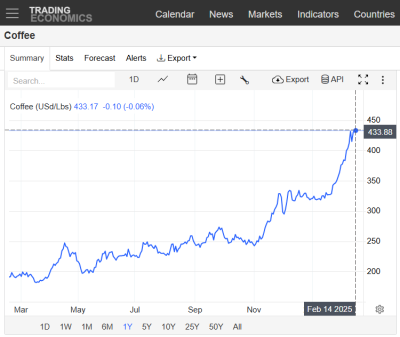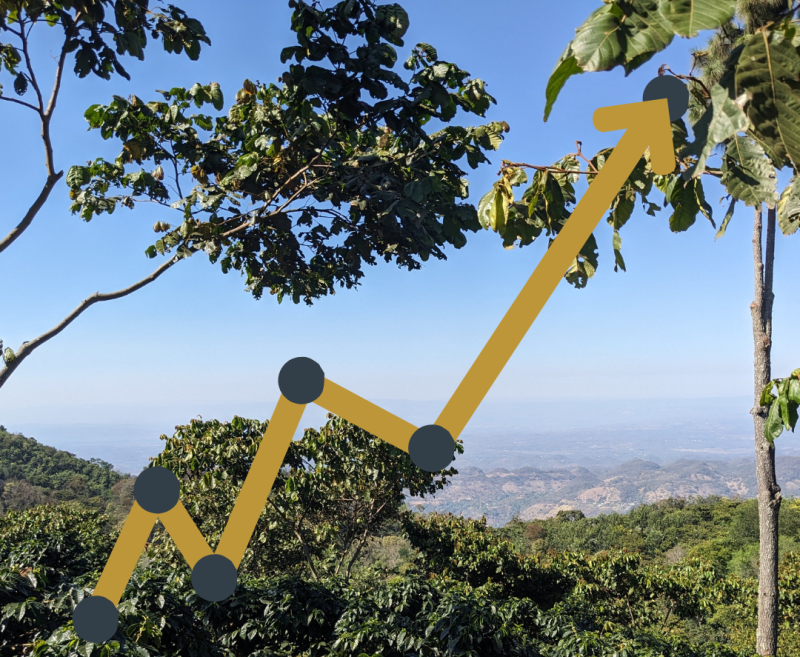A Look at the Global Market from Green to Cup
Sourcing great coffee means everything to us at Voyager, but like many in the industry, we’re navigating the challenges of a volatile coffee market. If you’ve noticed coffee prices rising, you’re not alone. The coffee industry is facing unprecedented challenges that are driving up costs at every stage—from farmers and importers to roasters and, ultimately, your daily cup. So, what’s behind this surge? A combination of climate change, global supply chain disruptions, and market speculation. As prices reach record highs, we wanted to share what’s happening, why it matters, and how we’re navigating these challenges while staying true to what we believe in: bringing you great coffee and supporting those who grow it.

In 2024, the industry saw a sharp surge in coffee prices, climbing by over 80%. As of early 2025, the market has jumped 33.5%, reaching an all-time high of 437.45 USd/Lbs in February. Trading Economics. Like any other commodity, when costs rise at every stage of production, the impact is felt throughout the supply chain.
See graph for market prices on 14.02.25 Trading Economics
What Is the Coffee Market?
Coffee is traded globally, with green coffee (unroasted coffee beans) moving from farms to roasters all over the world. But before it reaches our roastery, it has already been on a long journey – grown, harvested, processed and dried, ready for export.
Farmers sell their coffee in different ways, depending on farm size, access to buyers and resources. Some sell their cherries to local cooperatives, where they are processed and exported. Others have the ability to process their coffee themselves and sell directly to importers or roasters.
The global coffee trade operates within two main markets:
- The Commodity (C) Market – This is the stock exchange price for coffee, influenced by supply, demand, speculation, and global economic trends.
- The Specialty Coffee Market – Separate from the commodity market, specialty coffee commands higher prices based on quality, traceability and relationships between farmers, importers, and roasters.
While specialty coffee is often sourced independently of the C-market, it’s still not immune to price fluctuations. When commodity coffee prices rise, specialty coffee follows suit. Bram De Hoog
“The 80% increase in coffee prices over a year signals both a welcome opportunity and potential challenges for the industry. While higher prices offer relief for producers, the sharp rise creates ripple effects throughout the supply chain.” Primavera
Why Are Coffee Prices Rising?
There is no single reason behind the price increases – it’s a combination of climate issues, speculation and supply chain pressures all hitting at once.
Climate & Production Issues: Extreme weather events in Brazil and Vietnam – two of the world’s biggest coffee producers, have caused lower yields and uncertainty around future harvests.
- Brazil has faced droughts, frosts, and heavy rains, which could significantly impact the 2025 harvest. Bossa
- Vietnam, the largest producer of Robusta, has seen yields drop by 20% in 2024 due to shifting weather patterns. MCC
- Rising global temperatures mean coffee farms are being forced to higher altitudes, increasing production costs.
“Climate issues continue to disrupt coffee production globally, affecting all major producing countries. Safety stocks are running low in both producing and consuming nations.” Bossa
Market Speculation & Supply Chain Disruptions: with uncertainty in production, global coffee supply is tightening.
- Some farmers are holding onto stock, hoping for even higher prices before selling.
- In Brazil, only 20% of the 2024 harvest remains unsold, which has pushed green coffee prices even higher. Bossa
- The futures market has driven up both Arabica and Robusta prices by 60% in 2024. MCC
What Does This Mean for the Coffee Industry?
For Farmers: Although we hope that these impacts can benefit farmers at origin, higher prices do not always mean higher profits. Many farmers sell their coffee at pre-agreed fixed prices, meaning they don’t benefit from sudden market spikes. Rising costs of labour, fertilizers, and transportation make specialty coffee harder to sustain. Some farmers may switch to commodity coffee where they can earn similar profits with less investment. Primavera
For Specialty Coffee: Prices for high-scoring coffees (85+) are rising alongside commodity coffee.
Some producers may reduce investment in specialty coffee if they can earn the same revenue in the C-market without the added effort.
“Working with the same producers year after year has a direct impact. By sourcing responsibly and through traceable means, we’re committing to the future—helping coffee farming remain resilient in the face of ongoing challenges.” Bossa
For Roasters Like Us: Independent roasters like us feel price increases immediately, as we buy many of our coffees at market rates. Larger companies that hedge their purchases can delay these price shifts.
Rising costs of packaging, shipping, and energy further impact on our ability to absorb price hikes.
Despite these increases our focus remains the same:
- Sourcing high-quality, ethically traded coffee
- Maintaining strong relationships with farmers and suppliers
- Ensuring the people producing coffee are paid fairly
For You, Our Customers
The good news? We will keep roasting great coffee:
- Maintaining the consistency of our house blends and bringing in exciting single origins.
- We remain committed to sourcing responsibly – working with trusted importers to ensure fair pricing for producers and quality for you.
- We’ll be transparent – keeping you informed about market shifts and any adjustments in pricing. You will see small shifts in pricing as we continue to source quality coffee.
“This is where commitment to supporting high-quality producers becomes critical. Recognizing and rewarding their efforts ensures specialty coffee remains viable and valuable.” Primavera
Coffee prices are at record highs and the industry is facing unprecedented challenges. But by staying informed, supporting transparent sourcing and maintaining relationships, we can keep great coffee accessible while ensuring a fair future for the people who grow it.
You can find additional context in these industry articles:
Perfect Daily Grind: Coffee Market Volatility
The Grocer: Coffee Prices Hit New Highs
Why the price of your cup of coffee is set to rise | The Independent
“How the C-Market Shapes Coffee Pricing and the Global Supply Chain” | by Bram De Hoog | Medium
A Look at Prices — Primavera Green Coffee
Navigating Coffee Price Volatility: Insights from Origin – Bossa Coffee Company
